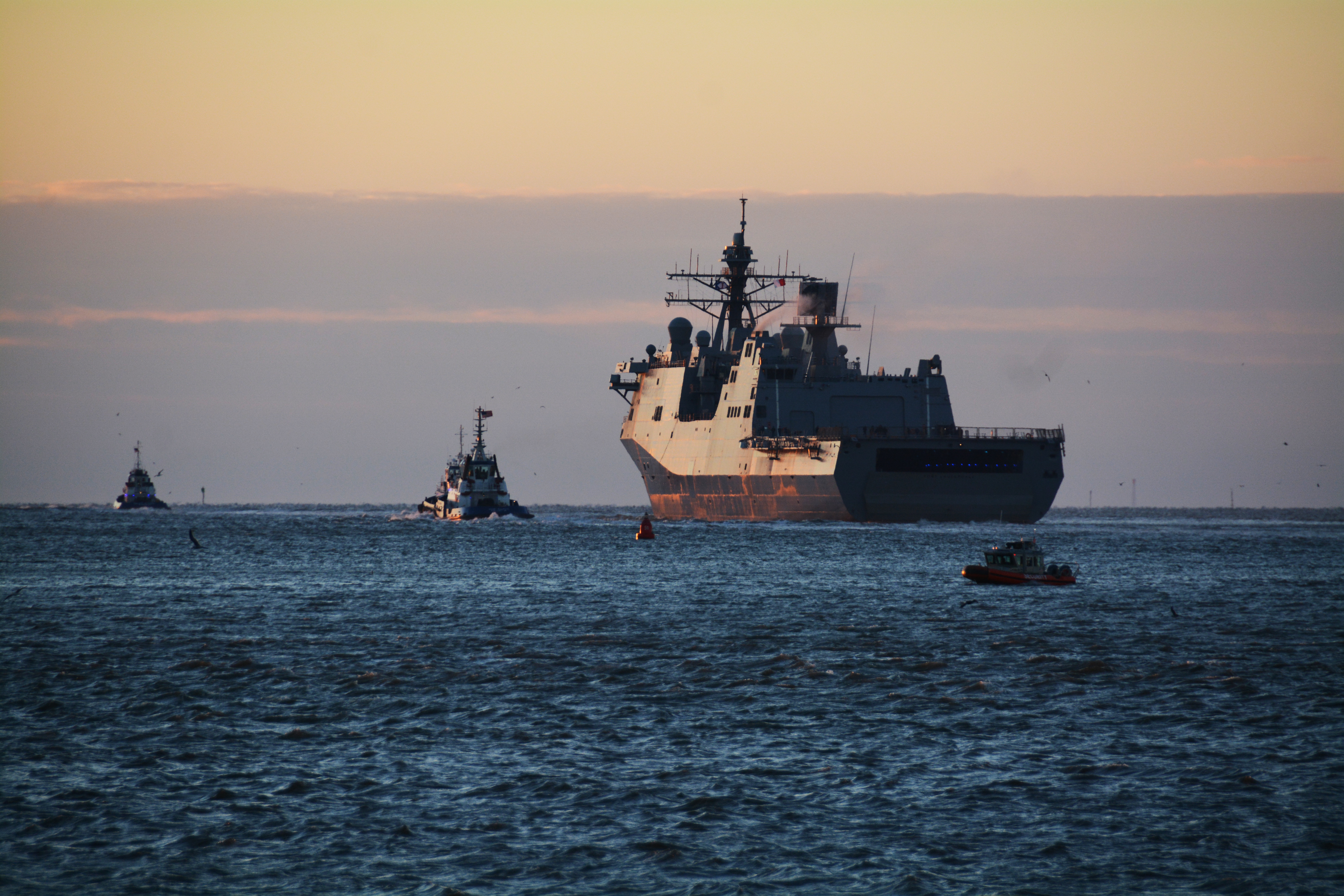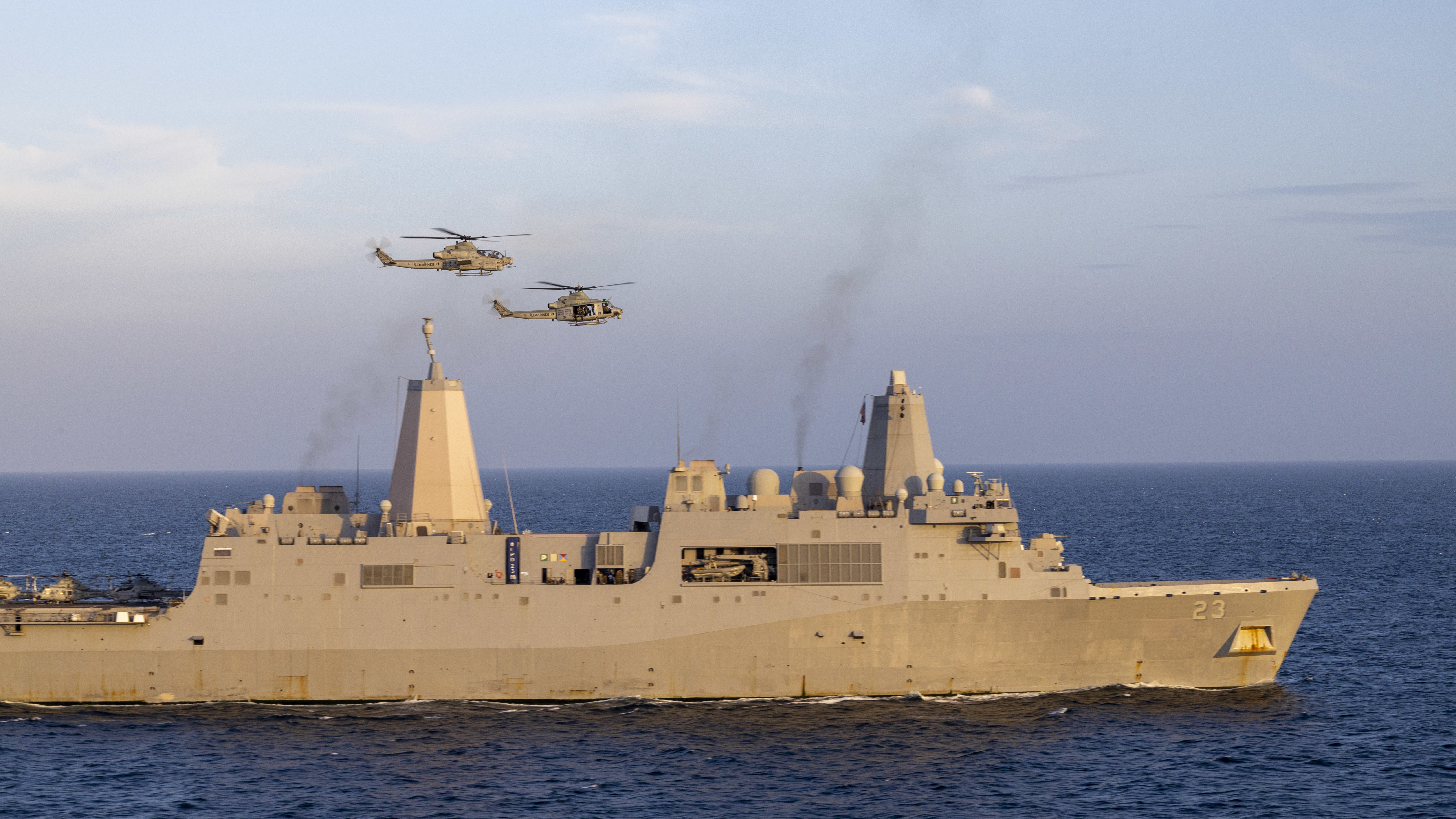
This story has been updated to include additional information about ship cost numbers from Marine Corps Commandant Gen. David Berger.
WASHINGTON, D.C. – The Navy halted its pursuit of the San Antonio-class amphibious transport dock line because of the program’s growing costs and delays in the shipyard, the service’s top officer said Wednesday.
The pause to reassess the LPD-17 Flight II line started a year ago at the direction of the Office of the Secretary of Defense, Chief of Naval Operations Adm. Mike Gilday said at the annual McAleese Conference.
“The cost of that ship had gone from $1.47 billion to the second ship at $1.5 [billion]. The third one that we’re contracting for right now is probably going to be between $1.9 and $2 billion,” Gilday said about LPD-30, LPD-31, and LPD-32, respectively.
“So that increase will be somewhere between 21 and 25 percent. The FY-[25] ship, unless we did a bundle buy, would likely be a $2 billion or above – at least a 25 percent increase. We’re moving in the wrong direction.”
The pause on buying amphibious ships is so the Navy can perform a Battle Force Ship Assessment and Requirements Study, which will help inform amphibious ship buys and likely wrap up in the third quarter of FY 2023, and evaluate both possible cost savings and capabilities, officials have said.
The Navy has yet to issue the award for LPD-32, which Congress authorized and appropriated funding for in Fiscal Year 2023. The Navy wanted that ship to be the last LPD-17 Flight II purchase, as the service last year tried to end the line early after only buying three ships instead of the originally planned 13.
After appeals from the Marine Corps for advanced procurement funding for LPD-33, lawmakers opted to continue the line and allotted $250 million in advanced procurement dollars for that ship in the FY 2023 funding and policy bills.
But the service did not include the ship in its five-year budget outlook released Monday. The Navy could buy LPD-33 in FY 2025 if it followed industry’s recommendation to order the ships every two years to keep a stable work force and maintain the supply chain. Because of the two-year centers, Gilday said the Navy has time to evaluate the LPD-17 Flight II line.
“Congress has given us the authorities in the latest [National Defense Authorization Act] to do a bundle buy and we all agree that that’s the way that we ought to go after these ships. But to go after a single ship in ‘25, and put that in the budget now – based on where we are with all this churn on cost and so forth and this concern about the cost of those ships – it’s like telling a car dealer, ‘hey I really want to buy that minivan. I’m going to buy that minivan. Now let’s roll up our sleeves and talk about price,’” Gilday said.
“It’s not going to drive down the price of that ship. It needs to be competitive. Actually, with that production line and that ship, it’s not competitive. One company builds it,” the CNO added.

But the Marine Corps has a different take. At the same conference, Marine Corps Commandant Gen. David Berger made the case for the LPD-17 Flight II line and said a block buy acquisition strategy is the way to pursue the ships to save money. The commandant argued that HII’s Ingalls Shipbuilding is approaching the point in the line where they can see cost savings and that increased costs to buy new LPDs are because of inflation.
Berger described LPD-27, part of the Flight I line, as a $2 billion ship in base FY 2014 dollars. LPD-28 and LPD-29 – which are both part of the LPD-17 Flight I line but are considered transition ships to Flight II – cost $1.66 billion and $1.62 billion, respectively, also in base FY 2014 dollars, according to Berger. The commandant didn’t know if LPD-32 would cost $2 billion, as Gilday estimated, but he noted the contract has not been issued.
“You could say it’s more expensive today. Well yeah, so is a gallon of milk, right, than last year. I got that. But in base dollars, I think industry is driving that price down … because you manufacture anything new, there’s a learning curve, a cost curve,” the commandant said. “They are right on the curve where they’re driving down cost now. If you stop and then restart it, everybody in this room knows what’s going to happen.”
Berger was part of the team in 2014 that assessed the LPD-17 line and chose to pursue an altered design – Flight II – instead of starting from scratch on a new amphibious ship program. He expressed doubt that the Navy could find more cost savings by doing another assessment and said halting the line would affect the workforce and drive the price up.
“For a year and a half, little by little, [we looked at] what could be pulled out of there but still do what we needed to do,” Berger told reporters of the 2014 evaluation.
“So from my perspective, that thoroughness that I saw and all of the staff meetings and all that took us to the final Navy decision to go with the Flight II – all that made perfect sense. And there was a lot of head butting on every little detail. So I don’t know doing that again with the same ship – I don’t know what you find out that we don’t already know.”
Naval Sea Systems Command chief Vice Adm. Bill Galinis could not provide details when asked if NAVSEA is formally assessing the LPD design or looking at a potential Flight III.
“We’re always looking at ways to drive cost down in the shipyards. And the shipbuilders are a key part of that – in fact they bring probably some of the better ideas because they’re building them. So we leverage what the shipbuilders bring to us,” Galinis told reporters.
Both Berger and Gilday argued for block buys to achieve cost savings, a point Navy Secretary Carlos Del Toro echoed in advocating for potential multi-year procurement strategies.
“I think it’s necessary to try to get to why is the cost of the LPD going up as significantly as it has. It’s now approaching pretty much the cost of a DDG Flight III destroyer,” Del Toro said.
“So there are some concerns to that. So we’re going to actually take a look at that over the next few months actually, hopefully by either June or September we’ll have the final answer to are there ways that we could perhaps bring that cost down a bit.”
Ingalls Shipbuilding, which builds the LPDs at its yard in Pascagoula, Miss., said it will deliver LPD-29 – the last Flight I ship – to the Navy this year.
“While Ingalls cannot comment on total price to the Navy, over the last five ships this partnership has enabled us to hold the line on shipbuilder cost. In 2016, LPD 28 was awarded for $1.47B (shipbuilder cost) and seven years later LPD 32 was negotiated with additional scope for $1.54B (shipbuilder cost), or within 5% of the LPD 28 award. Ingalls is committed to this partnership in support of our customers and country in delivering this powerful capability to the fleet,” Ingalls spokeswoman Kimberly Aguillard said in a statement.
Berger cited his minimum requirement of 31 amphibious ships, which Congress signed into law in FY 2023, as the reason why he cannot support the pause in purchasing LPDs.
“They’re right at the point in the curve that’s the most efficient and we’re going to take a time out. From my perspective, I can’t accept that when the inventory – the capacity has to be no less than 31,” the commandant said.





